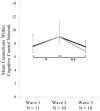Changes in alcohol-related brain networks across the first year of college: a prospective pilot study using fMRI effective connectivity mapping
- PMID: 23395930
- PMCID: PMC3616613
- DOI: 10.1016/j.addbeh.2012.12.023
Changes in alcohol-related brain networks across the first year of college: a prospective pilot study using fMRI effective connectivity mapping
Abstract
The upsurge in alcohol use that often occurs during the first year of college has been convincingly linked to a number of negative psychosocial consequences and may negatively affect brain development. In this longitudinal functional magnetic resonance imaging (fMRI) pilot study, we examined changes in neural responses to alcohol cues across the first year of college in a normative sample of late adolescents. Participants (N=11) were scanned three times across their first year of college (summer, first semester, second semester), while completing a go/no-go task in which images of alcoholic and non-alcoholic beverages were the response cues. A state-of-the-art effective connectivity mapping technique was used to capture spatiotemporal relations among brain regions of interest (ROIs) at the level of the group and the individual. Effective connections among ROIs implicated in cognitive control were greatest at the second assessment (when negative consequences of alcohol use increased), and effective connections among ROIs implicated in emotion processing were lower (and response times were slower) when participants were instructed to respond to alcohol cues compared to non-alcohol cues. These preliminary findings demonstrate the value of a prospective effective connectivity approach for understanding adolescent changes in alcohol-related neural processes.
Copyright © 2013 Elsevier Ltd. All rights reserved.
Conflict of interest statement
Authors declare that they have no conflicts of interest.
Figures




References
-
- Andersson JLR, Jenkinson M, Smith SM. Nonlinear registration, aka spatial normalisation. 2007 FMRIB technical report TR07JA2 from www.fmrib.ox.ac.uk/analysis/techrep.
-
- Bressler SL, Menon V. Large-scale brain networks in cognition: Emerging methods and principles. Trends in Cognitive Sciences. 2010;14(6):277–290. - PubMed
Publication types
MeSH terms
Grants and funding
LinkOut - more resources
Full Text Sources
Other Literature Sources
Medical

